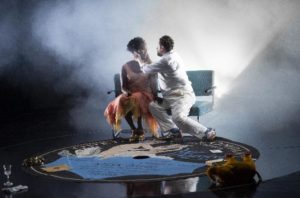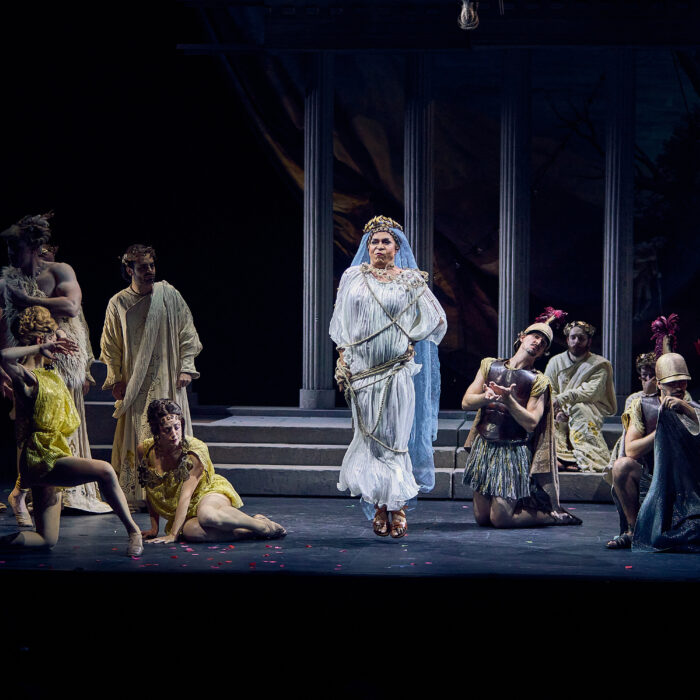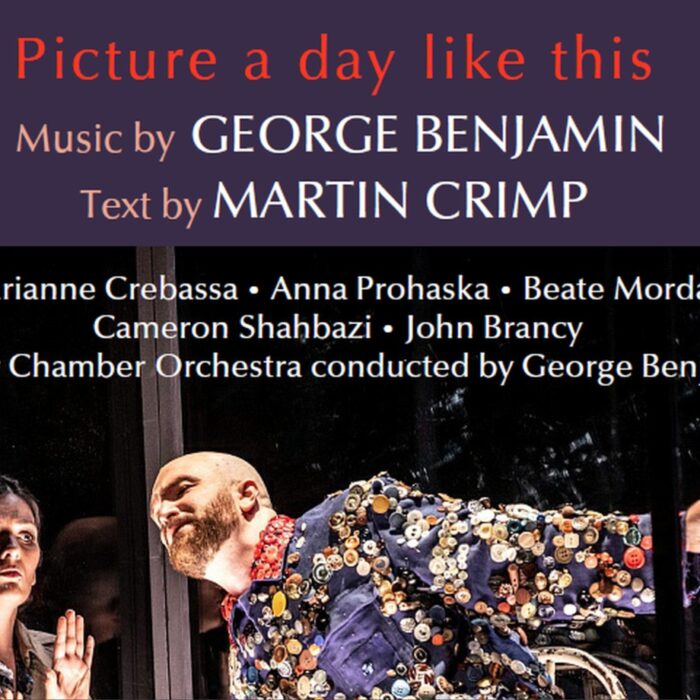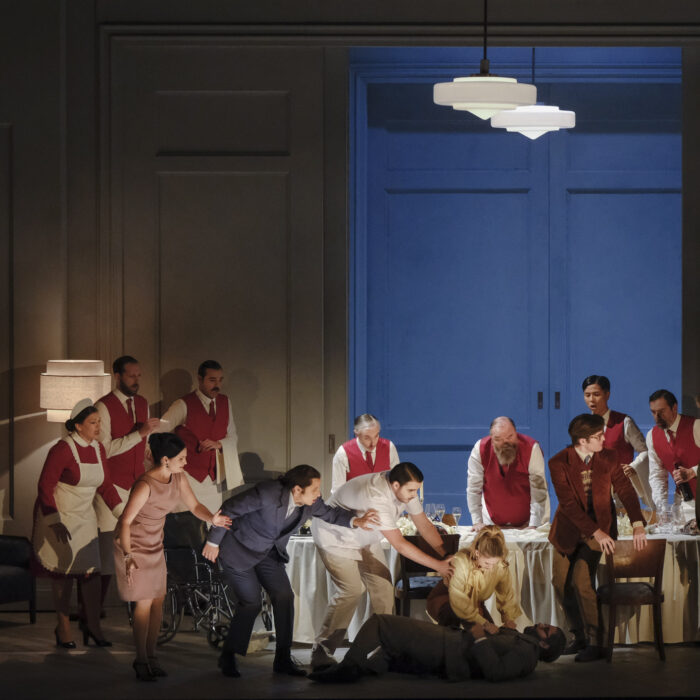
Opera Forward Festival 2019 Review: Caruso a Cuba
Fantastical Story Is Supported By Brilliant Score & Strong Leads
By Alan NeilsonIn 1920, the world famous tenor Enrico Caruso was in Cuba to sing the part of Radamès in Verdi’s “Aida,” for which he was to receive the princely sum of $10,000 per performance.
During the rehearsals Caruso was in an anxious state, arising from his health problems, exacerbated by the Caribbean heat, and the threats he was receiving from the mafia who were trying to extort money from him, when a bomb exploded, causing Caruso to run off into the street dressed in full costume and make-up. This much is fact.
Taking Up the Story
Composer and poet, Micha Hamel, takes up the story in his new opera, “Caruso a Cuba,” itself based on Mayra Montero’s novel, “The Messenger”: Caruso, running wildly along the street, in a state of panic, meets a young woman, appropriately named Aida, who immediately falls in love with him and offers to help him escape from his enemies.
She is the goddaughter of a Lukumi priest, Calazan, who by interpreting the Ekuele (shells used for predicting a person’s fate) already knows of Caruso’s arrival and the fact that Aida will fall in love with him, as well as of his forthcoming death (Indeed, Caruso did actually die the following year in Naples in 1921). Aida turns to her godfather for help, who states that Caruso must first appease the Gods, for it is his presence in Cuba which has caused the disturbance in the cosmos.
He therefore undergoes a ritual, in which he is submerged into a lagoon, and experiences visions of his youth in Naples, and realizes how lonely he has become as an international celebrity. Nonetheless, the threats from the Mafia continue, and at one point Caruso and Aida are attacked, in which he is badly beaten and she is abducted.
Eventually, Caruso, now emotionally destroyed, is forced to flee the island for New York. Although Aida aids his escape, she knows that she will never see him again, and that he will never see his child, which she is carrying.
It is a multi-layered story that moves between the human and the spirt worlds, in which Aida and Caruso fight with the gods, in order to alter their fate. It is also a portrayal of man who is destroyed by the fame in which he is imprisoned. Of course, it is never clear that this is not a monstrous dream into which Caruso has projected his inner demons.
Eclectic Musical Mix
Listening to “Caruso a Cuba,” which was given its world premier at Amsterdam’s “Opera Forward Festival,” it was clear that this had been written by a composer who is confident in his own abilities, and with the necessary maturity, to engage with the subject in an honest and direct fashion; there was no sense that the music was composed to show off his skills, or that he was trying to instruct or educate his audience.
The overriding priority was, clearly, to create an opera of quality, in which the music was there to play its part in promoting the drama. Hamel adopted a flexible approach, prepared to use any musical style which suited his purpose, and displayed courage in fully embracing stylistic elements of Italian Romanticism and bel canto, although not slavishly so; he even goes so far as to insert recordings of Caruso singing, and to incorporate a couple of quotations from Verdi, including four bars from “Aida,” thereby offering himself up for comparison. Structurally, Hamel was happy to use any forms which he considered necessary, including musical interludes and set piece duets and arias. After all, how could an opera about Caruso not include arias?
His interesting and imaginative choices relating to instrumentation, and the decisions he made regarding the size of the musical force employed, created an engaging score which not only had a strong momentum, which maintained the work’s dramatic cohesion, but also successfully created and managed the changing atmosphere of the work.
In fact, over the course of the opera, which lasts approximately one hour 50 minutes, without an interval, the musical style changes significantly. At the start, it is more traditional, drawing on Italian Romanticism, but as Caruso’s emotional state deteriorates the music slides towards a more discordant, atonal style, and the instrumentation becomes a lot freer, making increasing use of electronic sounds. Individual parts, most notably in the case of Caruso himself, also start to move away from tonal music, although not uniformly so. In fact, Hamel, does not completely abandon tonal music nor set forms.
Overall, the score is an eclectic mix, in which the styles have been successfully brought together purely to meet the dramatic requirements of the drama.
Being a poet, Hamel also took the opportunity to write his own libretto in Italian, in which he also happens to be fluent. This was an important feature as it is the language of Caruso, and having the character sing in Italian added to the verisimilitude of work, as well as capturing the Italianate Romantic sound world.
A Colorful Atmosphere
The conductor, Otto Tausk, produced an atmospheric and colorful performance from the Netherlands Kamerorchest, which captured the many different moods and emotions explored in the drama; Caruso’s increasing anxieties were highlighted through emphasizing the music’s edgy contours, whilst the graceful lyricism and beauty during oases of tranquility, which he experienced during the love scenes, were lightly and delicately drawn.
Tausk was attentive to the score’s rhythmic qualities, its dynamic changes, and the balance between passages for solo instruments, (or small sections of the orchestra, of which there were numerous instances), and passages for the full orchestra. This allowed the drama to flow at shifting speeds, with varying degrees of emotional depth, and successfully maintained the dramatic tension.
The highpoint of the work is definitely the lagoon scene, in which Tausk allowed the combined forces of the orchestra to create a climactic sound, before softening to allow for Caruso’s reflections. It is a fast moving, yet atmospheric score, subject to frequent and sometimes violent changes, all of which Tausk and the Netherlands Kamerorchest dealt with commendably.
Being Caruso
In the central role of Caruso was the tenor, Airam Hernandez, who successfully managed to capture the essence of the character; dressed in a white suit with a Panama hat, possessing a similar physique, and adopting the big gestures of a man of the stage, he could not be mistaken for anyone other than the great tenor.
Moreover, Hernandez’s sweet lyrical and expansive bel canto singing, aided by the beauty of his warm middle register, added to the portrayal. The love duet with Aida, in particular, was sensitively and beautifully rendered. For large parts of the performance, however, we watched on as Caruso is subjected to increasing emotional pressure, in which Hernanadez successfully shifted from a lyrical to a more psychologically intense and emotionally disturbed presentation, his voice becoming stretched and discordant, in a compelling portrait of a man whose emotional framework is on the point of collapse.
Aida
The soprano, Jeanine De Bique, made an equally successful impression in the role of Aida, whom she presented as compassionate, loving, sympathetic, and at times feisty. It was, however, the beauty of De Bique’s singing that really caught the attention. The voice has an attractive, young, fresh quality, burnished with a silvery coating, which she used to deliver a sparkling performance.
Her singing was full of well-crafted phrase, subtly allied to the meaning of the text, which in the more lyrical passages allowed her to develop long arching lines of exquisite beauty. Moreover, the voice is agile and supple, and lost none of its radiance as it soared gracefully upwards.
Priests & Beyond
Bass Simon Shibambu certainly looked the part as the Lukumi priest, Calazan; bare-chested and clothed in traditional African dress, he stood with a commanding air, dispensing his wisdom and judgement. His voice was well-suited to the role; dark and resonant, authoritative and firm.
Shibambu, however, was careful not to create a distant, remote figure. Instead, he engaged passionately with his goddaughter’s predicament, in what was a convincing portrayal. The one slight criticism was that when standing towards the back of the stage he did not project the voice with sufficient power.
Aida’s mother was essayed by the American mezzo soprano Tichina Vaughn. She cut an impressive figure, especially in the second act scene, in which she appears as a saint, dressed in long white robes, with a silvery headdress.
Vocally, she gave a committed and expressive performance, her colorful pallet adding to the intensity of her characterization. However, she did occasionally lose a certain amount of control as she pushed into her upper register.
Bass-baritone Cody Quattlebaum created a strong portrait of Caruso’s manager Bruno Zirato although it was not exactly a flattering one: he was clearly self-seeking and fun-loving, using Caruso to further his own lifestyle. He was most noticeable in the opening scenes when he indulged himself along with the rest of Caruso’s followers in a surreal dance, which could have been taken from the theatre of the absurd. Vocally he gave a strong performance.
Michael Wilmering played a number of roles, including the impresario Adolfo Bracale and made a pleasing impression, putting in a strong acting and vocal performance.
Likewise, the mezzo-soprano, Eva Kroon, interpreted numerous small parts, and gave a good account of herself. Gabriel Rollinson was also multi-parted and produced a solid performance. With so many roles being undertaken by the same singers, more should have been done to differentiate their roles, which tended to morph into each other.
Vinyl 78
The director, Johannes Erath and his team comprising Katrin Connan, responsible for scenography, Noelle Blancpain, costume design, Bernd Purkrabek, lighting and Bibi Abel video footage, for the main part, did a fine job in bringing “Caruso a Cuba” to the stage.
The set consisted primarily of a large vinyl 78 record, which was used as a tilted surface, upon which most of the action took place. Videos projected onto a transparent curtain, front of stage, were used to good effect to create the atmospheric effects, and was particularly successful in the lagoon scene, in which Caruso is immersed into the water.
Blancpain’s costumes for the main characters were pleasing on the eye and helped define the character, but for the lesser roles everything was slightly confused. It was never exactly clear who they were, nor when their roles changed, which on occasions, had the knock-on effect of making the narrative difficult to follow. Blancpain missed an opportunity to help clarify the situation by differentiating the characters through distinctive costuming.
Erath’s direction compounded the problem, as there was insufficient clarity to their parts. However, his treatment and direction of the main characters, was excellent; Caruso’s nervous deterioration and his relationship with Aida were expertly developed, as were the roles of Calazan and Aida’s mother, and their relationships to the spirit world.
The opera starts with Caruso asleep on his record; does he really wake up or was it all a dream? Erath’s decision to create this ambivalence was maintained throughout, and allowed for somewhat surreal yet powerful visual ideas to be presented; at one point, for example, Caruso is surrounded by a cast dressed as Caruso. He can see only himself, even in other people, such are the distortions of fame!
To date, Hamel has composed one tragic operetta, ”Snow White,” which was widely acclaimed at the time, and a number of works which he defines as music theatre, but “Caruso a Cuba” is his first opera. It is an opera which has a lot to offer, both musically and dramatically, and deserves to be taken up by other companies, and opened up to a wider audience. Hopefully, Hamel will use its success as a platform for the creation of further operas in the near future.


